| View previous topic :: View next topic |
| Author |
Message |
Elise

Joined: 22 Dec 2009
Posts: 243
Location: New York State



|
 Posted: Sep 07, 2011 10:39 Post subject: Re: Mineral specimens with inclusions Posted: Sep 07, 2011 10:39 Post subject: Re: Mineral specimens with inclusions |
|
|
| John S. White wrote: | | Here is a nice inclusion in a fluorite cleavage from Cave-in-Rock, Illinois. The cleavage is about 3 cm across. The inclusion is the tiny dot just to the right of the center of the cleavage. When magnified you can see a gas bubble in liquid and under the microscope it is possible to see that the bubble is flattened against all of the six sides of the rectangular hole in the fluorite.. |
Just amazing John! I would love to see that sometime and wonder about the flattening - I've some chicken and the egg thoughts, but maybe you already have theories? There have been so many wonderful examples and such great photography contributed to this thread already - so exciting!
Below is a drawing of a now extinct amber specimen from the Dominican Republic with a photograph of the relatively large two-phase liquid and gas inclusion within it prior to death. It shows what can happen with inclusions - last summer we experienced a stint of tornado spawning weather in which I believe the sharp changes in pressure caused the specimen to explode; it is the only clue I have to finding it in pieces a week or so before it was to have its portrait taken by Jeff Scovil. The lapidary left little material around such a large inclusion and the amber was brittle enough not to withstand the fluctuations. This can also happen with included minerals, especially those having easy cleavage, in situations such as a hot car trunk or window or with smaller specimens in the hot darkfield well of a microscope (not just liquid and/or gas inclusions, but also with solid mineral inclusions which change deferentially compared to the host mineral). Just as a note, you can watch phase changes under the microscope and get clues to identifying the liquid or gas in the inclusion (or just to have fun), but only with care!
A bit in haste, but thank you all for contributing to this wonderful topic!
Elise
| Description: |
Extinct Dominican Republic Amber with a large two-phase liquid and gas inclusion and a string of smaller bubbles above it (drawing).
27.28 x 22.10 x 10.21 mm |
|
| Viewed: |
47052 Time(s) |
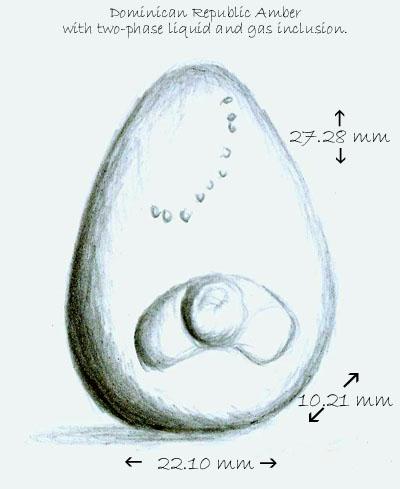
|
| Description: |
Dominican Republic Amber with large two-phase liquid and gas inclusion.
The bubble moved around the bend easily when tilted. |
|
| Viewed: |
47063 Time(s) |
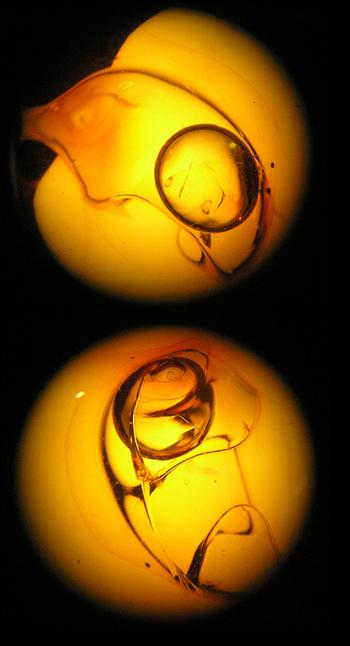
|
_________________
Elise Skalwold |
|
| Back to top |
|
 |
Elise

Joined: 22 Dec 2009
Posts: 243
Location: New York State



|
 Posted: Sep 07, 2011 10:56 Post subject: Re: Mineral specimens with inclusions Posted: Sep 07, 2011 10:56 Post subject: Re: Mineral specimens with inclusions |
|
|
| al mar wrote: | | Elise, I have seen some very similar blue quartz specimens from Brazil . |
I believe that it is from there, but I had not confirmed it yet with the friend I got it from.
On Amir's The Quartz Page (one of my very favorite sites, right from its beginings), he lists blue quartz from that locality as well: Jenipapo Mine, Itanga, Minas Gerais, Brazil https://www.quartzpage.de/blue.html and with a much better photograph!
_________________
Elise Skalwold |
|
| Back to top |
|
 |
Duncan Miller

Joined: 25 Apr 2009
Posts: 138
Location: South Africa



|
 Posted: Sep 08, 2011 02:41 Post subject: Re: Mineral specimens with inclusions Posted: Sep 08, 2011 02:41 Post subject: Re: Mineral specimens with inclusions |
|
|
| Jordi Fabre wrote: |
I have nothing against great threads like this one, but against the junk basar of catchpenny "jewelry" that tends to flood many minerals shows as invasive species! ;-)
|
Hi Jordi - I am sure everyone here appreciates your guidance of this forum and I did not want to give the impression of criticising you :) Perhaps you will forgive this gemmological intrusion.
Sometimes cutting is necessary to reveal the inner beauty of battered crystals and I only cut damaged specimens. Here is an example cut from a broken Madagascan quartz point, keeping the original outline to show up the hollandite (or so I am told) sprays decorating a phantom face, now near the bottom of the stone. Hope you enjoy it!
Duncan
| Description: |
Quartz with hollandite (?) inclusions
Madagascar
20.8 x 14.8 mm 15.86 ct |
|
| Viewed: |
47162 Time(s) |
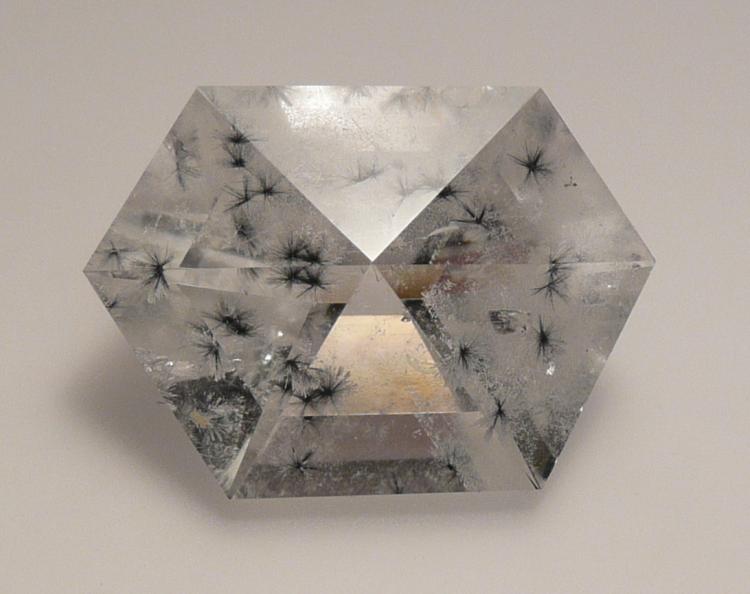
|
|
|
| Back to top |
|
 |
Duncan Miller

Joined: 25 Apr 2009
Posts: 138
Location: South Africa



|
 Posted: Sep 08, 2011 02:49 Post subject: Re: Mineral specimens with inclusions Posted: Sep 08, 2011 02:49 Post subject: Re: Mineral specimens with inclusions |
|
|
Elise
Not only heat but also unaccustomed cold can damage some included crystals (as of course can an ultrasonic bath). A Canadian dealer reportedly once lost an entire consignment of Tsumeb cerussites that shattered in the trunk of his car parked overnight in an unheated hotel garage.
Duncan
|
|
| Back to top |
|
 |
Maxilos
Joined: 02 Nov 2010
Posts: 191
Location: Boskoop, The Netherlands



|
 Posted: Sep 08, 2011 03:48 Post subject: Re: Mineral specimens with inclusions Posted: Sep 08, 2011 03:48 Post subject: Re: Mineral specimens with inclusions |
|
|
I have been looking through my collection and found this amethist. The the location I don't know, maby somewhere from Norway (bought in Trondheim). What I do know is that it has inclusions. If I remember correctly he said: "It is amethist with rutile inclusions, nice specimen!" But correct me if I'm wrong.
And I have this apophyllite from India (mayby you remember it) with heulandite inclusions.
I have also one question since haüyne is one of my favorites: Is it possible for a mineral to have haüyne inclusions?
Mark
| Description: |
Amethist with unknown inclusions
Largest: about 10x3,7x3cm; smallest: about 6,6x3,4x2,5cm |
|
| Viewed: |
46969 Time(s) |
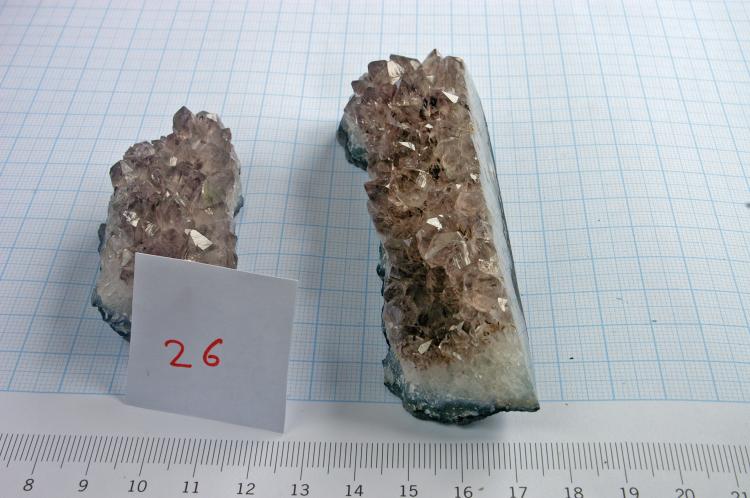
|
| Description: |
Amethist with inclusions
field of view: about 0,5cm |
|
| Viewed: |
46968 Time(s) |
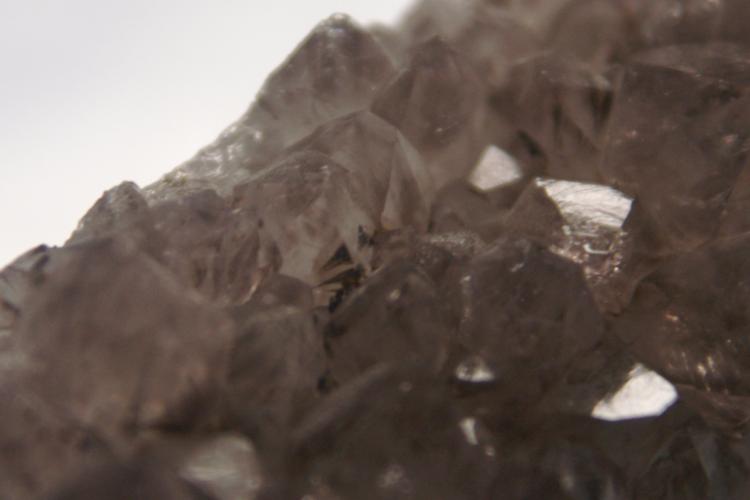
|
| Description: |
Amethist with inclusions
Field of view: about 0,5cm |
|
| Viewed: |
46983 Time(s) |
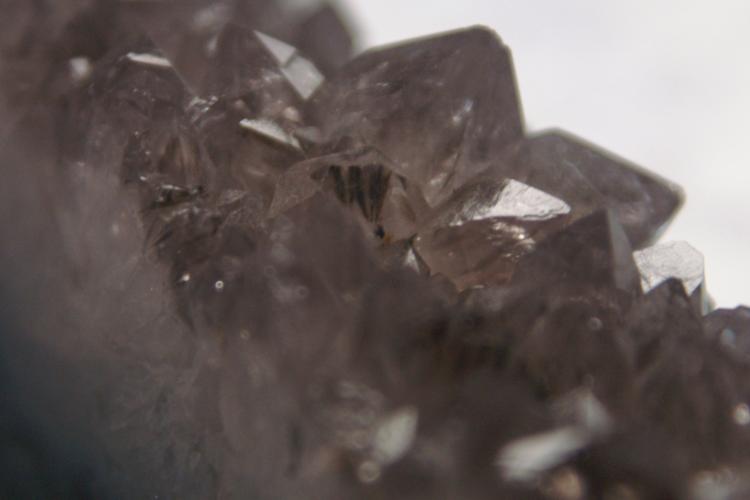
|
| Description: |
Amethist with inclusions
Field of view: about 0,5cm |
|
| Viewed: |
46994 Time(s) |

|
| Description: |
Apophyllite with heulandite inclusions
India
About 8,5x8,75x5,5cm |
|
| Viewed: |
47009 Time(s) |
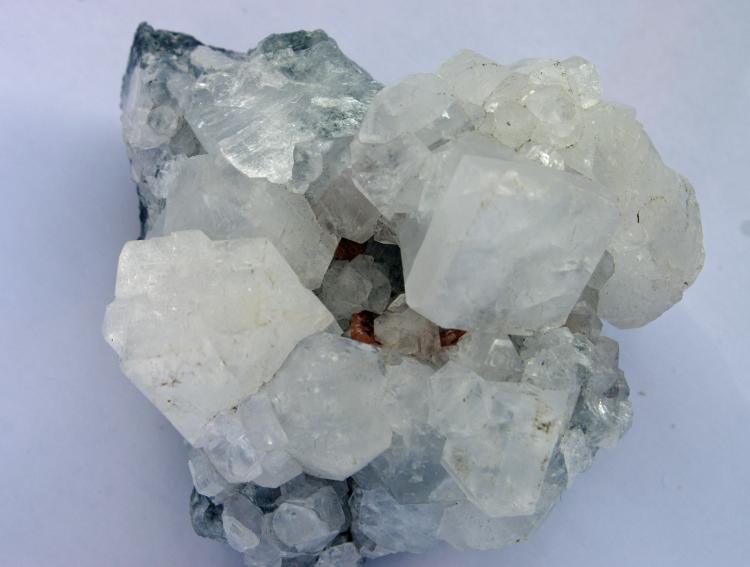
|
_________________
"Still looking for the philosopher's stone" => Dutch proverb |
|
| Back to top |
|
 |
Duncan Miller

Joined: 25 Apr 2009
Posts: 138
Location: South Africa



|
 Posted: Sep 08, 2011 04:46 Post subject: Re: Mineral specimens with inclusions Posted: Sep 08, 2011 04:46 Post subject: Re: Mineral specimens with inclusions |
|
|
Maxilos
The 'rutile' in your specimen look a lot like the cacoxenite tufts in this amethyst. Admittedly it is tricky to identify such inclusions visually, but according to Webster's "Gems" cacoxenite inclusions are common in amethyst. (OK, I will stop posting cut stones now.)
Duncan
| Description: |
Quartz with cacoxenite inclusions
Brazil
12 mm square, 10.89 ct |
|
| Viewed: |
47337 Time(s) |
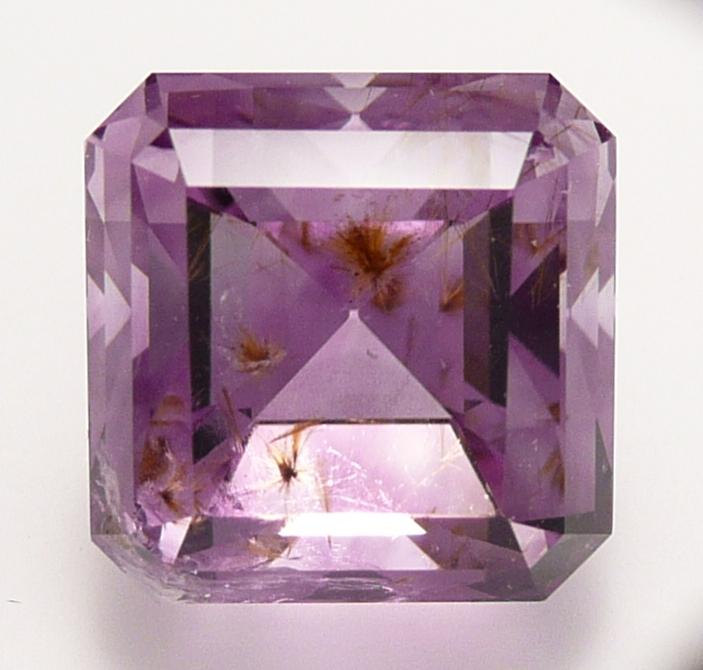
|
|
|
| Back to top |
|
 |
John S. White
Site Admin

Joined: 04 Sep 2006
Posts: 1298
Location: Stewartstown, Pennsylvania, USA



|
 Posted: Sep 08, 2011 05:20 Post subject: Re: Mineral specimens with inclusions Posted: Sep 08, 2011 05:20 Post subject: Re: Mineral specimens with inclusions |
|
|
Oh please, not "cacoxenite" again! What does one have to do to permanently bury this false identification. The inclusions in amethyst from Brazil are NOT cacoxenite, they are goethite, as has been stated more than once on FMF. In fact, on this very thread, just days ago, I posted a photo of amethyst with goethite inclusions. Here it is again. Duncan, did you not notice that? There are no phosphates associated with the geodes that contain the amethyst from Rio Grande do Sul. Never, in my experience, has any misidentification been perpetuated to the degree that this one has. Goethite, please, and it is quite clear that the piece Maxilos has is goethite.
Finally,just because our fearless leader Jordi does not like polished pieces, please continue to post photos of them when appropriate. I fully intend to.
| Description: |
|
| Viewed: |
47323 Time(s) |
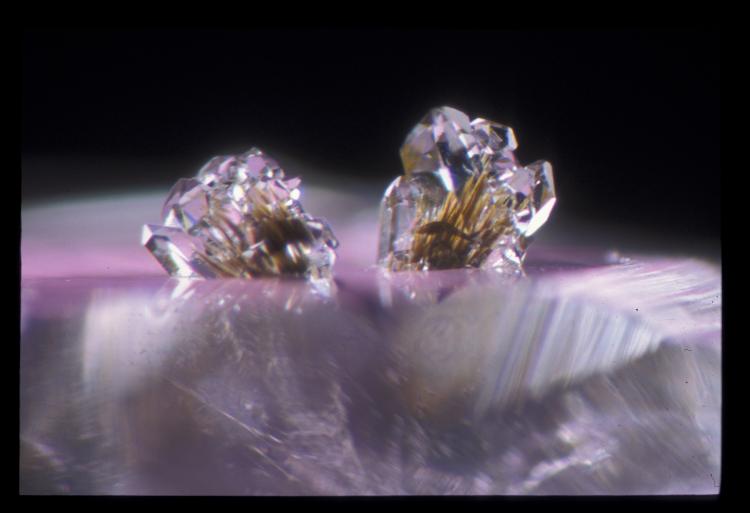
|
_________________
John S. White
aka Rondinaire |
|
| Back to top |
|
 |
Duncan Miller

Joined: 25 Apr 2009
Posts: 138
Location: South Africa



|
 Posted: Sep 08, 2011 05:51 Post subject: Re: Mineral specimens with inclusions Posted: Sep 08, 2011 05:51 Post subject: Re: Mineral specimens with inclusions |
|
|
Hi John
I am glad to have been corrected, thank you. Yes, I did notice your photo of the goethite, saw its similarity to the tufts in my amethyst, and tried to cover myself by saying that visual ID is dicey! (The edition of Webster's Gems I referred to was the 5th edition, reprinted 2003, edited by Peter Read.) As to what one has to do to bury such false identifications permanently, perhaps there is a need for a cumulative 'recurrent false IDs' thread with illustrated examples.
Duncan
|
|
| Back to top |
|
 |
John S. White
Site Admin

Joined: 04 Sep 2006
Posts: 1298
Location: Stewartstown, Pennsylvania, USA



|
 Posted: Sep 08, 2011 08:13 Post subject: Re: Mineral specimens with inclusions Posted: Sep 08, 2011 08:13 Post subject: Re: Mineral specimens with inclusions |
|
|
Hi Duncan:
Thank you for your response. It is interesting that the 2003 edition of Webster's Gems would make that mistake. I do not have that book, but my copy of Webster's Gemmologists' Compendium (6th edition 1979) carries the statement: "the name (cacoxenite) is often misleadingly applied to quartz (often amethyst) containing yellowish tufts of goethite."
It is amazing that Peter Read would change what was correct to something incorrect.
_________________
John S. White
aka Rondinaire |
|
| Back to top |
|
 |
Antonio Alcaide
Site Admin

Joined: 23 Aug 2009
Posts: 314
Location: Spain



|
 Posted: Sep 08, 2011 19:36 Post subject: Re: Mineral specimens with inclusions Posted: Sep 08, 2011 19:36 Post subject: Re: Mineral specimens with inclusions |
|
|
Very nice drawings, Elise. Please, keep on posting them.
Regards
_________________
Life is the shortest crystal |
|
| Back to top |
|
 |
Jordi Fabre
Overall coordinator of the Forum

Joined: 07 Aug 2006
Posts: 5026
Location: Barcelona



|
 Posted: Sep 13, 2011 02:36 Post subject: Re: Mineral specimens with inclusions Posted: Sep 13, 2011 02:36 Post subject: Re: Mineral specimens with inclusions |
|
|
| xenolithos wrote: |
...As to what one has to do to bury such false identifications permanently, perhaps there is a need for a cumulative 'recurrent false IDs' thread with illustrated examples.
|
Is a sub-forum in FMF, "Incorrect classification and fakes" , where the false identifications can be discussed. Antonio created there a new thread: "Goethite -not cacoxenite- inclusions in amethyst from Brazil" ( https://www.mineral-forum.com/message-board/viewtopic.php?t=1939 ) where this topic of the Goethites-not Cacoxenites has been copied.
|
|
| Back to top |
|
 |
Elise

Joined: 22 Dec 2009
Posts: 243
Location: New York State



|
 Posted: Sep 13, 2011 18:20 Post subject: Re: Mineral specimens with inclusions Posted: Sep 13, 2011 18:20 Post subject: Re: Mineral specimens with inclusions |
|
|
| xenolithos wrote: | | visual ID is dicey! (The edition of Webster's Gems I referred to was the 5th edition, reprinted 2003, edited by Peter Read.) |
Duncan, it is wise that you point out that we shouldn't be making "sight IDs" from photographs, only perhaps opinions. My own thought is that even with the specimen in one hand and a book in the other, the process is fraught with pitfalls. The goethite inclusions in quartz come in so many different forms, as can be seen in John Koivula's Photoatlas, but I am not sure I would have recognized it conclusively in any of the photos above. I wonder what caused an author to make the initial mistaken ID of cacoxenite despite its rarity and incompatible chemistry with quartz or its growth environment. Or perhaps it was based on morphology alone.
It is an interesting aside that in Frondel (7th) the presence of goethite pointed to the role of iron in the purple color; it mostly forms in the colorless areas - I assume this where the iron is taken up by the growing goethite; a kind of chromophore canniblization to use a Koivula expression (correct me if that is a wrong assumption). It is also a factor in the formation of Brazil law twinning, though at almost nano-crystal scale.
Also, I am not sure how to distinguish goethite from hematite, other than in a case such as the image below where the goethite has transformed to hematite, shown as black tips as its growth environment dehydrated (Koivula). You can see some of this color zoning in the crystal cluster below, along with the numerous tufts. Jaroslav Hyrsl wrote that "is difficult to differentiate goethite, hematite and rutile when completely enclosed in quartz." so I should not feel too badly.
| John S. White wrote: | | It is interesting that the 2003 edition of Webster's Gems would make that mistake. I do not have that book, but my copy of Webster's Gemmologists' Compendium (6th edition 1979) carries the statement: "the name (cacoxenite) is often misleadingly applied to quartz (often amethyst) containing yellowish tufts of goethite."It is amazing that Peter Read would change what was correct to something incorrect. |
John, the editions before and after carry the same mis-identification; all three by noted mineralogist/gemmologist editors; I don't have the 3rd edition by the original author to know whether it had been changed. It was also so by mineralogist and famed inclusionist Dr. Gübelin, though corrected by John Koivula in all editions of their co-authored Photoatlas series (I can point to other types of similar errors in Sinkankas, Hurlbut and numerous journals as well). Was this started in the gemological community or in the mineralogy world? I am feeling my knees getting weak and a faint rubbery feeling develop in my other limbs.
Carry on!
Elise
| Description: |
| Golden goethite transitioning to black hematite; an inclusion in the amethyst quartz cluster shown below; unknown locality, approx. 3.5 mm (photo: E. Skalwold). |
|
| Viewed: |
47026 Time(s) |
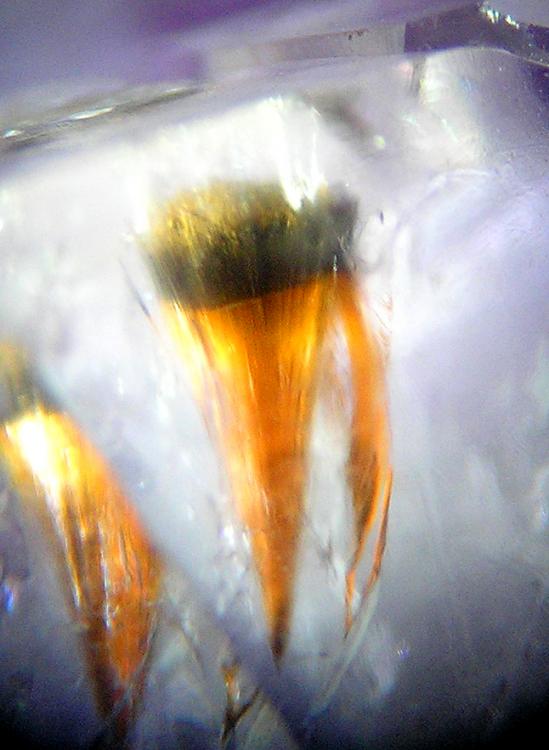
|
| Description: |
| Amethyst quartz, unknown locality, approx. 4 inches across (photo: E. Skalwold). |
|
| Viewed: |
47098 Time(s) |
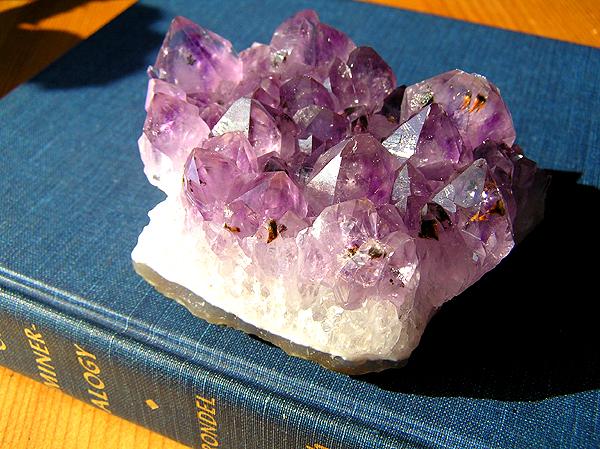
|
_________________
Elise Skalwold |
|
| Back to top |
|
 |
dtkasper
Joined: 27 Dec 2010
Posts: 13
Location: Lancaster


|
|
| Back to top |
|
 |
dtkasper
Joined: 27 Dec 2010
Posts: 13
Location: Lancaster


|
 Posted: Sep 13, 2011 22:07 Post subject: Re: Mineral specimens with inclusions Posted: Sep 13, 2011 22:07 Post subject: Re: Mineral specimens with inclusions |
|
|
Goethite/cacoxenite.
Melody wrote a recent book on healing stones. She is a prolific writer of her analysis of all the powers of stones of the world. She is out of England. She labelled cacoxenite as having extraordinary powers unlike any other inclusion. The rest is history. Value of the stuff went through the roof. For the superstitious, you lose. This is why it continues to be perpetuated.
_________________
I collect, therefore I am. |
|
| Back to top |
|
 |
dtkasper
Joined: 27 Dec 2010
Posts: 13
Location: Lancaster


|
 Posted: Sep 13, 2011 22:09 Post subject: Re: Mineral specimens with inclusions Posted: Sep 13, 2011 22:09 Post subject: Re: Mineral specimens with inclusions |
|
|
I have never seen goethite dendrites in an agate. These appear to be one of the manganese dendritic minerals.
_________________
I collect, therefore I am. |
|
| Back to top |
|
 |
|





